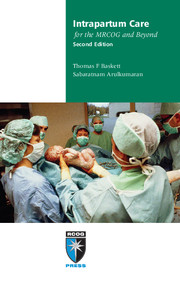Book contents
- Frontmatter
- Contents
- Preface
- Abbreviations
- 1 Improving intrapartum care
- 2 First stage of labour
- 3 Second stage of labour
- 4 Fetal surveillance in labour
- 5 Third stage of labour
- 6 Lower genital tract trauma
- 7 Induction of labour
- 8 Preterm labour and prelabour rupture of membranes
- 9 Assisted vaginal delivery
- 10 Shoulder dystocia
- 11 Breech vaginal delivery
- 12 Twin and triplet delivery
- 13 Caesarean section
- 14 Vaginal birth after caesarean section
- 15 Uterine rupture
- 16 Emergency obstetric hysterectomy
- 17 Cord prolapse
- 18 Antepartum haemorrhage
- 19 Postpartum haemorrhage
- 20 Acute uterine inversion
- 21 Amniotic fluid embolism
- 22 Disseminated intravascular coagulation
- 23 Acute tocolysis
- 24 Severe pre-eclampsia and eclampsia
- 25 Neonatal resuscitation
- 26 Perinatal loss: management of late fetal death and stillbirth
- Index
14 - Vaginal birth after caesarean section
Published online by Cambridge University Press: 05 July 2014
- Frontmatter
- Contents
- Preface
- Abbreviations
- 1 Improving intrapartum care
- 2 First stage of labour
- 3 Second stage of labour
- 4 Fetal surveillance in labour
- 5 Third stage of labour
- 6 Lower genital tract trauma
- 7 Induction of labour
- 8 Preterm labour and prelabour rupture of membranes
- 9 Assisted vaginal delivery
- 10 Shoulder dystocia
- 11 Breech vaginal delivery
- 12 Twin and triplet delivery
- 13 Caesarean section
- 14 Vaginal birth after caesarean section
- 15 Uterine rupture
- 16 Emergency obstetric hysterectomy
- 17 Cord prolapse
- 18 Antepartum haemorrhage
- 19 Postpartum haemorrhage
- 20 Acute uterine inversion
- 21 Amniotic fluid embolism
- 22 Disseminated intravascular coagulation
- 23 Acute tocolysis
- 24 Severe pre-eclampsia and eclampsia
- 25 Neonatal resuscitation
- 26 Perinatal loss: management of late fetal death and stillbirth
- Index
Summary
Since the 1980s, caesarean section rates have risen worldwide. In many developed countries, one-quarter to one-third of all pregnant women have a caesarean delivery, while 10–12% of the obstetric population have been previously delivered by caesarean section. Thus, about one in ten pregnant women, and those looking after them, have to consider the implications for pregnancy, labour and delivery after previous caesarean section. The main consideration is the balance between the risks and benefits of elective repeat caesarean section versus trial for vaginal birth after caesarean section.
Selection
The most dreaded complication is, of course, uterine rupture (chapter 15). Thus, a trial for vaginal delivery can be contemplated only when the appropriate personnel and facilities are available. Anaesthesia, nursing and obstetric staff should be immediately available together with the appropriate operating facilities and blood transfusion. These issues have been reviewed in national society guidelines.
The principle of informed consent is very important in these women. Women should understand the maternal risks involved with caesarean section, both elective and after failed trial for vaginal delivery. The possibility of complete uterine rupture in labour (approximately 3–6/1000) should be presented together with the risk of perinatal death and/or severe morbidity should rupture occur: about 1–2/1000 more than with repeat elective caesarean delivery.
- Type
- Chapter
- Information
- Intrapartum Care for the MRCOG and Beyond , pp. 169 - 176Publisher: Cambridge University PressPrint publication year: 2011

